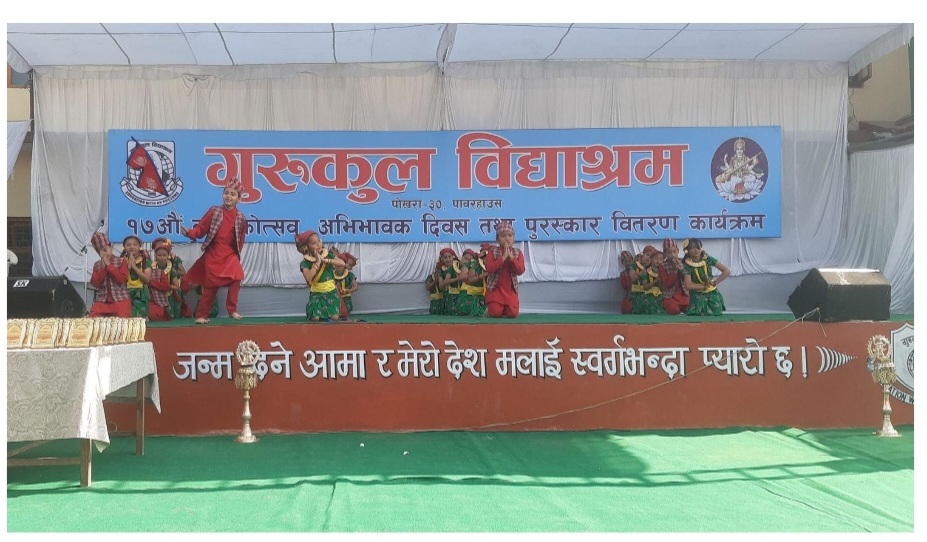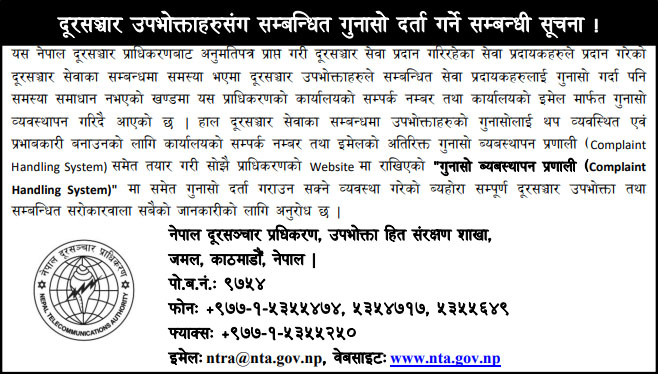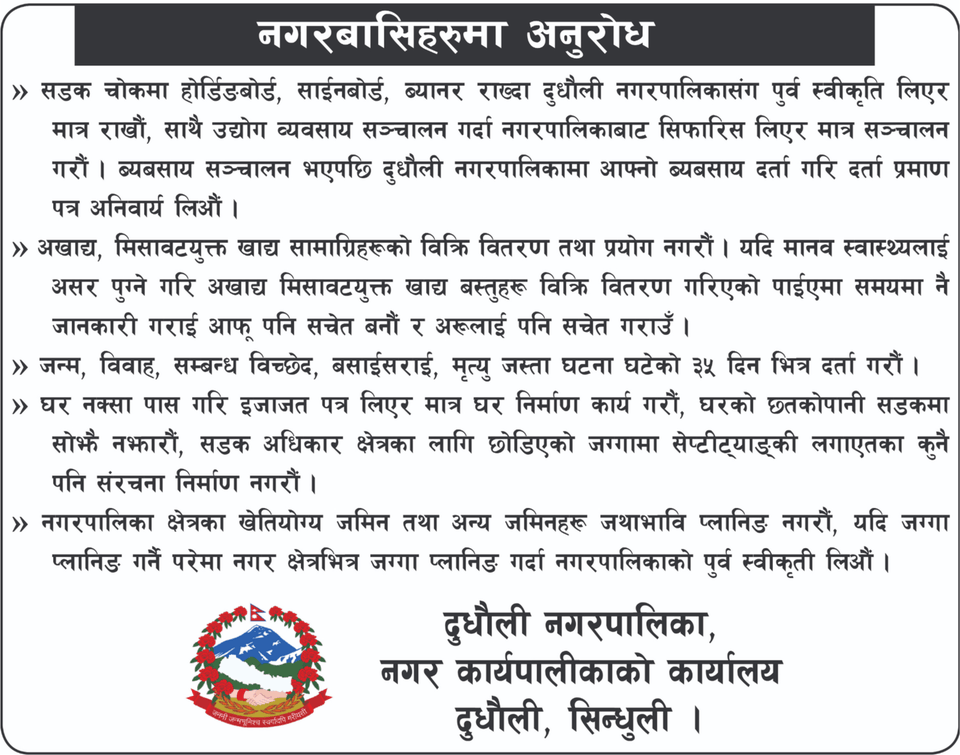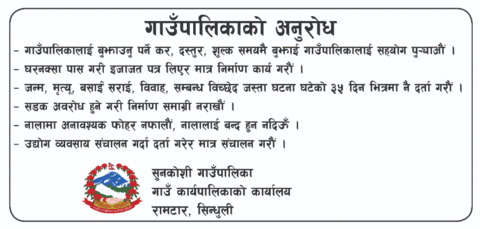-By NiranjanOjha(Ph.D.)
Abstract
Sino- Nepal relation is historic, traditional, comfortable and controversy free because of Chinese non-intervening foreign policy. Nepal and China never raised any issue relating to regional crisis in bilateral relation. China is a donor and leading investor in Nepal and providing continuous help and support. There are no unequal treaties between Nepal and China. China never engages in internal affairs as well as micro-management but expects stable and economically self-sustain neighbor.
China’s Nepal policy aims to accommodate each other’s political concerns, enhance economic cooperation on the basis of mutual benefit, boost people-to-people and cultural exchanges, and strengthen coordination and cooperation in international and regional affairs.
China always considers Nepal a true friend and wants to be a genuine development partner. From Chinese view Nepal more than just a ‘dear-friend’ and a close-neighbor, but an excellent- partner of China. Politically, China stands to support each other’s sovereignty and territorial integrity. Economically, China is helping Nepali friends through aid and investment and cooperation. This is a testimony of the fact that China attaches greater importance to Nepal and is willing to assist in Nepal’s quest for speedy development.President Xi’s visit will be a milestone in Nepal-China relation. Nepali people have a great respect to China and are eager to welcome Chinese President.
Introduction
Nepal, a small Himalayan country surrounded 3 sides by India in the south, east and west and one side by China in the north, is inhabited by heterogeneous ethic groups. Ecologically the country is divided into three regions, running east to west. They are the mountain, the hill and the Terai.
Sino-Nepalese relation is traditional and historic. Sino- Nepal relation is comfortable and controversy free because of Chinese non-intervening foreign policy. Nepal and China never raised any issue relating to regional crisis in bilateral relation. China is a donor and leading investor in Nepal and providing continuous help and support. There are no unequal treaties between Nepal and China.
After the unification of small kingdoms and petty Himalayan states, King Prithvi Narayan Shah said, “Nepal is a yam sandwiched between two large stones.” He was referring to India to the South and China to the North as two large stones, and Nepal as a yam in between them. He left his advice to his future generations to follow the policy of non- alignment, balancing the two powerful countries. China- Nepal treaty of peace and friendship1960 was a milestone between Nepal- China relations. Both countries believe on peaceful co-existence, Panchaseel and non-interference. Thirty years ago, China supported the idea of Nepal being a Zone of Peace. Many European and Asian countries supported too.
Nepal- China Historical Relation
Nepal and China, close neighbours, shares common border, have multi-dimensional relations. Nepal and China have a long history or cultural and political relations. Historically, political relation between the two countries goes back to seventh century C.E. During this period, official contact between the Nepalese Court and the T’ang dynasty were maintained through the exchange of political missions. However, official contacts between the two countries began in the fifth century CE through cultural delegations. Buddhism seems to have been the most important factor in the relationship between the two countries in ancient times. Religion and culture marked the basis of bi-lateral relations. From the historical point of view, friendly relations and cultural interactions between Nepal and China are important. Buddhism was the first linkage between People to people of the two countries. The Nepal-China traditional friendship gradually developed during the course of history of exchange of visits by Buddhists Masters of both countries. The legends, travelogues, historical records and monuments are the witnesses of relationship between the two countries. Buddhism played a vital role in Sino-Nepalese relations.
Buddhism was introduced into China during the Han Dynasty around the second century C.E. Gradually, Buddhism spread to all parts of China. After their rise to the power in the fourth century C.E., the Emperors of the Eastern Tsin Dynasty worked to promote Buddhist ideas by constructing monasteries. Sino- Nepal Relation stands for cultural exchange rather than political relation till medieval period. Though Nepal has political and economic relations with China too, Cultural exchange of Buddhism was the major factor in ancient period. According to SwayambhuPurana, Kathmandu Valley was a lake in the pre-historic time. Bodhissattava Manjushree came to Kathmandu valley from Wu tai-Shan in China and cut the gorge at Chobhar and drained out the valley. Visit of Buddhist monk-scholars Fa-hsien and Hsuan-tsang and Buddhabhadra, Nepali scholar’s visit to China in the fifth Century is the land mark in Nepal-China relation.
According to Prof. Hwang Jin Chao, medieval China had many things to learn from Nepal particularly Buddhist art and architecture. Nepalese artists built a number of famous monasteries, temples and stupas. Among them the most outstanding Nepalese artist was Araniko. Nepal and China had a very close relation during the Yuan Dynasty. During the reign of Emperor Kublai Khan, Nepali Artist Arniko visited Peking with Lama Phags-pa, the royal preceptor of Yuan Dynasty. Arniko worked for 30 years as an artist in the Yuan court. Likewise, legends of Bhrikuti are also the example of Nepal-China relation. Chinese traveller Li Yi Piyao visited Nepal during the reign of Licchavi King NarendraDev and Nepali King greeted him. King NarendraDev helped Chinese Ambassador Wang Huen Se 7000 horse with army to catch Arunoswo.
Nepal had a good relation with China even in the medieval age. Trade between Lhasa and Nepal was in high magnitude during Malla and the first half of Shah Period. After the kot massacre of 1846, Ranas came in the power. Anglo-Rana relation was very good thus they gave emphasis on Anglo- Nepal relation rather than Sino-Nepal relation. In the pre Shah – Rana period, Nepal fought war with Tibet. Because of Chinese support in 2nd Nepal-Tibet war Nepal was defeated. In Shah-Rana period, China refused Nepal’s request for assistance during Anglo- Nepalese War(1814–16), and was defeated by the British Empire in India. Nepal continued to try to balance the influence of China and British India. Through the tenth five yearly mission to China (1837), Under the leadership of ChautariyaPuskar Shah, the Nepalese government had requested for the Ching court to either send troops or send subsidy of twenty million rupees to oppose British, but the Nepalese delegation was said to have met with a stern refusal of its petition for monetary aid, and opposition to the furtherance of hostility by Nepal against the British. Nepal invaded Tibet in 1855, but the Nepal- Tibet war ended soon after China intervened, the Treaty of Thapathali, concluded in March 1856, and recognized the special status of China and Nepal’s commitment to help Tibet in the event of foreign aggression.
Diplomatic Relation and Nepalese Neutrality
In 1955, Nepal established diplomatic relations with the People’s Republic of China and exchanged resident ambassadors by 1960. In 1956, both nations signed a new treaty terminating the Treaty of Thapathali of 1856 and Nepal recognized Tibet as a part of China. In 1960, Nepal and China signed a boundary settlement agreement and a separate treaty of peace and friendship. Nepal also began supporting the change of China’s seat in the United Nations. In 1961, Nepal and China agreed to build an all-weather road connecting the Nepalese capital Kathmandu with Tibet. During the Sino-India war of 1962, Nepal maintained neutrality.
Nepal –China Strategic Relations
In the year 1970s King Birendra proposed Nepal as a “zone of peace” between India and China and in the 1980s; Nepal began importing Chinese weaponry in contravention of its 1950 treaty with India and has since sought to establish extensive military cooperation in a move to reduce perceived Indian influence. When the USA , UK and India refused to supply arms to the regime of King Gynandra, during the Civil War (1996–2006), China responded by dispatching arms to Nepal, in spite of the ideological affinity of the Maoists with China.
Nepal –China Economic Relations
Chinese Assistance to Nepal
China has contributed in road, bridge and infrastructural construction. Arniko Highway and its rehabilitation , Kathmandu Bhaktapur Road , Prithvi Highway, Narayanghat-MuglingRoad , Gorkha-Narayanghat Road, Majhuwa-Gorkha-Road, Trolly Bus , Kathmandu Ring Road(1st and 2nd) , Pokhara-Baglung Road , Seti River Bridge at Pokhara, Syafrubesi-Rasuwagadhi Road etc. Besides, China supported in various projects too. Civil Service Hospital, Kathmandu, B. P. Koirala Memorial Cancer Hospital, Bharatpur, Polytechnic Institute in Banepa, Nepal Television Metro Channel Station Expansion and improvement, International Convention Centre, Bansbari Leather and Shoes Factory, Hetauda Cotton Textile Mills, Harisidhi Brick Factory, Bhaktapur Brick Factory, Bhrikuti Paper Mills and Lumbini Sugar Mill. Now Nepal is awaiting Kerung- Kathmandu railway. China has been assisting Nepal since 1956. Chinese assistance towards Nepal is the highest in South Asia.China has been providing a good number of student scholarships in medicine, engineering and technical field. Likewise cultural exchanges, cultural fairs and programs have been organizing frequently. Now many Chinese projects (very important) under construction in Nepal are Gautam Buddha Airport, Pokhara Airport, Beautification and upgrading Tribhuvan International Airport and so on. Many Chinese private companies are engaged in infrastructure construction, hydro projects, irrigation projects and many more. Recently Chinese company has committed to construct Melamchi drinking water project within the given timeframe, which has been waiting since 30 years.
Six border points – Kodari- Zhangmu, Rasua-Kerung, Humla-Purang, Olangchunggola-Riyo, Kimathanka-Riwo and Nechung –Legze are easily accessible to the both side citizens residing 32 K.Ms. peripheri. These borders point helps both border people for their daily necessities.
China has designated Nepal as a tourist destination. Number of Chinese Tourist arrival is in increasinggraph which contributes to earn foreign exchange for a country whose export is minimal. Chinese direct investment is growing. Chinese investors are investing in the tourism and hospitality trade, garments, civil engineering, infrastructure and building construction, hydro power and electronics.
During a meeting with Chinese delegation on September 9, Foreign Minister PradeepGyawali reiterated Nepal’s commitment to nine projects under the BRI framework: the Kathmandu-Kyerung Railway, the MadanBhandari University, the Galchi-Rasuwagadhi-Kerung 400 KB Transmission Line, the 762 MW Tamor hydropower project, the 426 MW Fukot-Karnali Picking run-of-the-river hydropower project, upgrading of the Rasuwagadhi Highway, the Tokha-Chahare road, the Kimangthan-Hile road, and a road connecting Dipayal with Tibet.
Though no major agreement was signed but a hospital project in Manang was signed. Nepali officials said that Yi’s visit raised hopes for a major breakthrough in deadlocked BRI discussions in the coming months. The discussions surrounding BRI have been stalled due to disagreements about which projects to finance and how (whether through loans or grants.) The Chinese side expressed commitment to expand railway to Nepal and agreed to resolve outstanding issues for the same. This should be seen as a positive development.
PM Oli signed the historic Trade and Transit Treaty with China during his first visit as prime minister in 2016.China has topped the list of foreign direct investment pledges for three years running. Nepal now has access to seven Chinese seaports and dry ports, and discussions are underway to open up more border points between the two countries. A record number of Chinese tourists are visiting Nepal every year; the tourist district of Thamel boasts more than 100 Chinese restaurants. After Hongsi Cement, another Chinese cement factor is in the process of setting up a plant with an investment worth USD 140 million. In addition to providing scholarships to dozens of students, China also sponsors study tours for hundreds of Nepali civil servants, security personnel, politicians, civil society members, and journalists every year. In many Nepali primary schools, Chinese language has been introduced in the curriculum.
The size of Chinese aid has also increased. China pledged USD 483 million towards post-earthquake reconstruction; a significant increase compared to its previous development aid commitments. China is assisting 25 reconstruction projects, including Durbar High School and Basantapur Durbar. Part of the assistance is in the form of Rs 2.5 billion to the Nepal Army to support humanitarian assistance and disaster management.
Nepal wants projects worth an estimated USD 3 billion to build with a grant, while China wants instead to provide soft loans. If Nepal agreed, this would be the biggest loan in Nepal’s history, dwarfing other large Chinese loans, including Rs 22 billion to build Pokhara International Airport and Rs 7.08 billion loans funding the Trishuli 3 A hydropower project. Finally, China has agreed to build various projects including an industrial park at an estimated cost of NRs 333 billion.
The increased aid to Nepal-grants and loan-coincides with China’s increased economic might and its global leverage. The visiting delegation tried to convey to Nepali officials that China is ready to further up its assistance.China always considers Nepal a true friend and wants to be a genuine development partner. From Chinese view Nepal more than just a ‘dear-friend’ and a close-neighbor, but an excellent- partner of China. Politically, China stands to support each other’s sovereignty and territorial integrity. Economically, China will help Nepali friends through aid and investment and cooperation. This is a testimony of the fact that China attaches greater importance to Nepal and is willing to assist in Nepal’s quest for speedy development.
Chinese assistance for Bilateral Relation and co-operation to Nepal
Nepal constitutes an important element of China’s South Asia policy. One may recall Mao Zedong’s five finger policy in which Nepal constituted one of the five fingers along with Ladakh, Bhutan, Sikkim and Arunachal Pradesh. The five fingers were essentially meant to serve as a ‘new buffer’ zone between India and China after the ‘old buffer’ (Tibet) came under China’s sovereignty in 1951. With growing tensions in Tibet, particularly after the March 2008 uprising, China’s conception of Nepal as a new buffer acquired particular significance. Its policy towards Nepal came to be driven by the need to curb the clandestine activities of some 20,000 Tibetan refugees (the second largest Tibetan refugee community in the world) in Nepal. Consequently, During each of the high-level meetings China has extracted assurances from Nepal that it adheres to the one-China principle, acknowledges Tibet as an inalienable part of China, and will ensure that no anti-China activity is allowed on its soil.
China intended to develop relations with Nepal in a way that would serve as a role model for bilateral ties between big and small countries. China has, in fact, laid down a four-fold policy to strengthen its bilateral relations with Nepal: First, accommodate each other’s political concern. Second, enhance the economic cooperation on the basis of mutual benefit. Third, boost people-to-people and cultural exchanges. Fourth, strengthen the coordination and cooperation in international and regional affairs.
Apart from stating a clear policy towards Nepal, China has been systematically pursuing a multi-dimensional engagement with Nepal. There has been a flurry of visits between China and Nepal in recent times. China has been cultivating ties with not only the Communist Party of Nepal(CPN-) but also with the Nepali Congress and the regional Madhesi Parties. Nepal-China Mutual Cooperation Society (NCMCS), Nepal-China Executives Council in Kathmandu, the Nepal-China Friendship Association in Lumbini and the Nepal-China Youth Friendship Association in Pokhara are further strengthening Nepal-China relation.
BRI and China
BRI is a massive infrastructure and connectivity initiative of the Chinese government and a signature project of President Xi, loosely based on two main routes: the Silk Road Economic Belt and the 21st Century Maritime Silk Road. In Chinese the initiative is called (literally, ‘one belt one road’). The English name has changed from One Belt One Road (or OBOR) to the now widely accepted BRI. The BRI, it was first announced in 2013. While large investment projects characterized the initial phase, it now focuses on high-quality development, mirroring China’s growth path from ‘high-speed’ to ‘high-quality’. BRI has started China to connect the Eurasian region, but the Chinese government now aims to make this a ‘platform’, open for all countries to join, and for all interested investors to collaborate. The ‘Vision and Actions on Jointly Building Silk Road Economic Belt and 21st-Century Maritime Silk Road’ is the official blueprint for the BRI. It highlights the five main areas of the initiative: policy cooperation, infrastructure connectivity, trade connectivity, financial cooperation and people-to-people exchanges. Domestically, BRI helped China deal with a number of domestic challenges, including structural changes in the economy, shifting demographics, financial risk management, and poverty alleviation. Nepal’s participation in the Belt and Road Initiative (BRI) goes beyond physical connectivity and also includes connectivity of ideas, trade, people, finance and the whole spectrum of connectivity.
During the tenure of Prime Minister SushilKoirala, Nepal became a founder member of the Asian Infrastructure Investment Bank; during the tenure of Prime Minister K.P. Oli, Nepal signed the transit treaty; during the tenure of Prime MinisterPushpa Kamal Dahal“Prachanda”, Nepal joined the One Belt One Road (OBOR) initiative; and during the tenure of PM SherBahadurDeuba, Nepal allocated budget for the Detailed Project Report for the railway line from China. BRI is not only a bilateral agreement but the shortest route to facilitate our trade: both export and import.
In his opening speech to the 19th Congress of the Communist Party of China (CPC) in October 2017, President Xi Jinping reiterated the importance of international cooperation, and noted that even China could not cope with the challenges posed by global warming alone. In this statement we can see China’s willingness to be fully involved in world affairs.
Chinese President Xi’s commitments have clearly given priority to sustainable development projects along the Silk Road Economic Belt and the 21st Century Maritime Silk Road and the search for new partners for what is now jointly called the Belt and Road Initiative (BRI). The way the BRI is included in the CPC statute following the 19th CPC Congress makes the long-term implication of the BRI evident. The inclusion of the BRI by its name in the party statute of the CPC is a major step towards solidifying the initiative as a core plan of action that is to be carried out for an extended period in the future.
Xi Jinping Thought on Socialism with Chinese Characteristics for a New Era which also gives due emphasis to the BRI has now been a part of China’s constitution with its amendment through the NPC. The 19th CPC Congress also emphasized strengthening socialism with Chinese characteristics, party-building, and socialist rule of law, and setting concrete timelines for achieving development goals, such as building a moderately prosperous society and achieving socialist modernization. It also focused on augmenting China’s more substantial role. It has been six years since Chinese President Xi Jinping announced his signature foreign policy project, the Belt and Road Initiative (BRI). And although successive Nepali governments have committed to the BRI, Nepal is yet to select specific projects under it.
South Asia Institute of Advanced Studies (SIAS) and Institute of Geographic Sciences and Natural Resource Research, Chinese Academy of Sciences (CAS) jointly organized an international workshop on ‘Belt and Road Initiatives in Nepal: Opportunities and Challenges’ in Kathmandu on 7 August 2019. The event was organized with an objective of sharing insights and observations of various academics and think-tank scholars between Nepal and China to materialize the concept of BRI. The workshop delved into various aspects of the same ranging from the modalities of fostering the Green BRI to deepening academic and think-tank model collaboration between the two countries.
It has been generally accepted as a significant milestone aimed at promoting comprehensive connectivity and cooperation among the countries and people in the region and beyond. There are others who view BRI as a platform for country like Nepal to reduce its dependency. More than 130 countries of the world have signed MOU expressing their interest to become a part of this landmark initiative.
Barring a dramatic turn of events, Chinese President Xi Jinping is visiting to Nepal on Oct.12. To lay the ground for the visit, Chinese Foreign Minister Wang Yi completed a three-day trip to Kathmandu earlier last month. In recent years, high-level Chinese officials have been coming here with increasing frequency. But Xi will be the first Chinese President to come to Nepal in 23 years since Jiang Zemin’s trip in 1996.
Government officials say the Chinese foreign minister had three broad agendas—to take stock of the preparations for Xi’s security; to explore specific agendas during XI’s visit; and to create a conducive political environment for his visit. Wang held detailed discussions with Prime Minister KP Oli and President Bidya Devi Bhandari about Xi’s visit.
“Both sides underscored the importance of the exchange of high level visits on a regular basis in order to develop mutual trust and confidence, and to further strengthen bilateral relations.
Conclusion
China’s Nepal policy aims to accommodate each other’s political concerns, enhance economic cooperation on the basis of mutual benefit, boost people-to-people and cultural exchanges, and strengthen coordination and cooperation in international and regional affairs. Chinese President Xi Jinping announced his project, the Belt and Road Initiative (BRI) in 2013. Now it is 6 years of BRI and about 130 countries have joined it and Nepali governments have committed to the BRI. BRI is not only a project of connecting the world but it is specifically engaged with connecting eastern school of thought countering the western world. Shanghai cooperation forum, AIIB are the tools of BRI achieving its goal uniting eastern world. Nepal should understand it and have to take advantage from it.
Three Chinese leaders, Chairman Mao- political reformer, Chairman Deng- economic reformer and Chairman of Military Commission and President Xi- social reformer and realistic dreamer, and their attention towards Nepal are always high value to Nepal. Visit of President Xi not only strengthen Sino-Nepal traditional relations but also give message to entire world, South Asia and the neighbours. Thus this visit is meaningful to Nepal. Nepal should prepare to get maximum benefit from this visit. (Ojha is Associate Professor, Dept.of History, Tribhuvan University)
















Add Comment